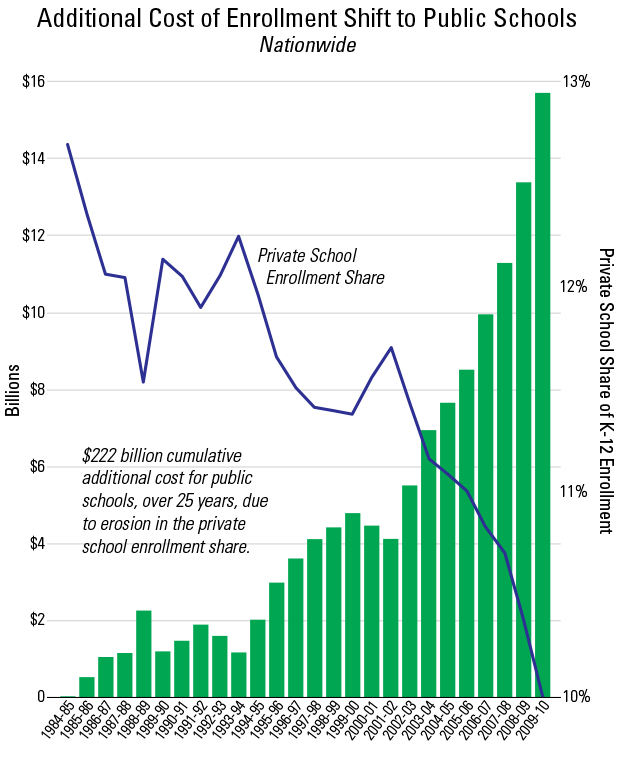If You Think Expanding School Choice Is Expensive . . .
…consider the alternative!
President Obama has yet again omitted funding for the D.C. Opportunity Scholarship Program in his recently proposed 2015 education budget. Although his reasoning is likely more philosophical than financial, his decision makes analyzing the fiscal effects of opposing school choice worthwhile.
Data from the U.S. Department of Education (DOE) show that taxpayers are bearing additional costs for funding K–12 education as a result of the continued erosion in private school enrollment.
By the 2009–10 school year, the private school share of K–12 enrollment nationwide had dropped nearly three percentage points, down to 10 percent since its peak of 12.7 percent in the 1984–85 school year. The DOE currently projects that enrollment shift, if unabated, will continue—falling further, to 9.1 percent, in 2020.
What has actually happened over this period of time? A sporadic expansion of school choice options on a state-by-state basis has served as a form of phase-in. Unfortunately, its pace has, thus far, been far too slow to fully offset the erosion in private school enrollment.
Critically, public schools have had to fill that gap, causing a substantial net additional fiscal cost that is rarely acknowledged by public officials.
Looking only at 2009–10, if the private school share had held steady at the 1984-85 level, about 1.5 million fewer students would have been enrolled in public schools. With America’s per-student spending average of $10,652 in public schools in 2009–10, taxpayers would have saved $15.7 billion that year alone.
Taking a broader view, if the private school enrollment share had held steady at 12.7 percent from 1985 through 2010, spending on the K–12 public schools across the United States could have been as much as $222 billion less! Check out the chart below to see for yourself.

Phasing in by cohort is merely a technical way of describing a voucher program that is expanded sequentially starting with a first group of incoming kindergarten students and then allowing all subsequent new classes of kindergarten students to be eligible. Thus, in year two of the program, both kindergarten and first grade students would be eligible. In year three, eligibility expands to students in kindergarten through second grade, and so on. Such a strategy would have served to moderate the voucher program’s growth and align its expansion more closely with the erosion rate in private school enrollment. Additionally, a phase-in by cohort could have been overlaid with other criteria, such as income limits or geographic boundaries, to control eligibility even more tightly if so desired.
In fairness, it would be rather difficult to design a nationwide school voucher program in such a restricted way that it would offset only the slow erosion in private school enrollment share (approximately 0.1 percent or 50,000 students per year). Because each new cohort is about four million students, any such program, even if restricted and phased in, likely would attract more participants than required just to offset the erosion rate. The upside is, if such a voucher program caused the private school enrollment rate to rise, the savings would be even more.
What has actually happened over this period of time? A sporadic expansion of school choice options on a state-by-state basis has served as a form of phase-in. Unfortunately, its pace has, thus far, been far too slow to fully offset the erosion in private school enrollment.
There’s no objectively “right” ratio for public school versus private school enrollment, but from a purely fiscal perspective, the larger the private school share the lower the public cost. For the ratio to return to somewhere near its 1985 level, the growth of school choice across the country will need to be accelerated by state lawmakers—because the president wants no part of it.




